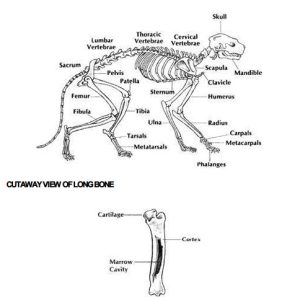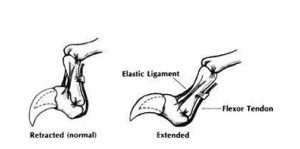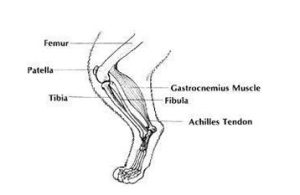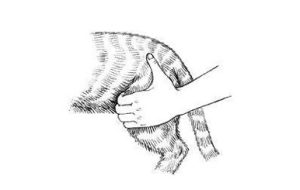The Classic Comprehensive Handbook of Cat Care
MUSCLE AND BONE
(MUSCULOSKELETAL SYSTEM)
Muscle tissue is composed of contractile units that provide the power for voluntary movement, breathing, blood circulation, digestion, glandular secretion, and excretion of body wastes, as well as many other more minor functions. There are three types of muscle tissue in your cat’s body.
Smooth or unstriated muscle is involved in a host of primarily involuntary body functions such as the peristaltic (wavelike) movements of the digestive tract. Cardiac (heart) muscle, which is capable of independent rhythmic contraction, is found only in the heart, the pump for the circulatory system. Skeletal or striated muscle makes up the rest of the muscles in the body, including the diaphragm and certain trunk muscles responsible for breathing. An illustration of the muscles in your cat’s body is not included in this book because knowing their positions and names is not important in giving routine health care at home.
Bone is a continually changing and actively metabolizing tissue in the living animal. It is composed primarily of the minerals calcium and phosphorus in an organic connective tissue framework that is mainly protein. The outstanding physical functions of bone are to form the skeleton, which supports and protects the soft tissues (e.g., organs, muscles, fat) of the body, and to provide levers against which the various skeletal muscles move. The bones have other functions as well. Mineral storage is provided in the hard bone itself, and fat storage and the formation of blood cells and antibodies occur in the marrow present inside the bones.
Each cat has about 244 bones in the skeletal structure, not including tiny bones called sesamoids normally associated with certain tendons. Names of bones that might be important to you in understanding your veterinarian’s diagnosis are marked on the skeletal drawing. See whether you can locate each of them on your cat with your hands.
Start with the skull (head). Notice its compact, round shape and short, powerful jaws. Thick and thin layers of muscle and connective tissue overlie the bones of the skull, but these tissues are not very prominent, and you may have difficulty distinguishing between the soft tissues and bone.
You may be able to feel the relatively thick, paired temporal muscles over the top of the head between the ears and the masseter muscles that lie in the area of your cat’s cheeks. These two pairs of muscles function together with smaller muscles to close the mouth. The rest of the skull feels very bony. Trace the bony area between the temporal muscles back to its end behind the ears. This small, hard bump at the end is called the occipital protuberance and is a normal part of every cat’s skull. Another bony area easy to identify is the mandible, the lower jaw. You move this bone when opening and closing your cat’s mouth.
The skull is attached to the rest of the skeleton by the cervical vertebrae.
Try to feel these neck bones by moving your fingers firmly over the sides and top of the neck. You will find it very difficult to feel any bony structures because of the well-developed muscles that cover the neck. The cervical vertebrae, along with the lower vertebrae, form your cat’s spinal column (backbone).
The thoracic vertebrae start in the area between the edges of the shoulder blades. You can feel the curved upper edge of each scapula (shoulder blade) near the middle of the back at the withers. Each scapula and the muscles that cover it can be seen to move freely when your cat walks and runs. Use your index finger to feel the spines of the thoracic vertebrae between the shoulder blades. Unless your cat is pretty fat you will be able to trace these bones with your finger down the center of your cat’s back. They become the spines of the lumbar vertebrae in the area behind the last rib and disappear near the hip where several vertebrae are joined to form the sacrum. You can feel only the spines of the vertebral bones but not the rest of the bones themselves because a heavy group of muscles lies on each side of the spinal column down the back. These epaxial muscles are most prominent in the lumbar region where you can feel them easily by running your fingers along each side of the spinal column. Unless your cat is tailless, you will probably be able to feel each coccygeal (tail) vertebra under its covering muscles.
Now examine each leg starting at the foot. The average cat has five digits (toes) on each of the front feet and four each on the back feet. Cats affected with polydactyly, an inherited trait, may have from one to four extra digits on the front feet; but extra toes on the rear feet are quite rare.
Feel each toe carefully. You will find that each consists of three bones (phalanges). These correspond to the bones in your fingers and toes. The first toe bone (first phalanx) and nail are covered by a fold of skin in the relaxed foot. These retractile nails allow your cat to walk quietly. To examine these, grasp the leg in the palm of your hand, place your index finger on the pad of the toe you want to examine and your thumb over the top of the same toe at the joint between the first and second phalanx, then squeeze your fingers together.
When you do this you will find that the toenail and first phalanx come into view and will remain extended until you release your fingers. Move your fingers slowly up each toe to the middle of the foot. In this area each toe is attached to a long bone that corresponds to the bones that form the palm of your hand and the sole of your foot.
These bones are called metacarpals in the front feet and metatarsals in the rear.
EXTENDING THE CLAW
The forepaw (front foot) attaches to the foreleg (front leg) at the carpus (wrist). Gently flex and extend this joint. If you palpate (examine with your hands) carefully, you may be able to feel the small, individual bones that form this joint. Above the carpus are the long bones of the foreleg, the radius and ulna. These bones are well covered by muscles on the lateral (outside) surfaces except in the region of the elbow, but if you feel deeply you will be able to feel bone through the muscle layers. On the medial (inside) surface you can easily feel a bone (the radius) near the wrist.
Place the fingers of one hand over the elbow. Grasp the foreleg below the elbow with your other hand, and flex and extend the joint. A normal joint moves smoothly with no grating or grinding vibrations felt by your fingers.
The humerus is the bone that forms the foreleg above the elbow. It is well covered with muscles that correspond to those of your upper arm. The humerus is most easy to feel at the point of the shoulder, but if you feel deeply in other areas you can also find it underlying the muscles.
Claw Mechanism
Another bone you may feel under the skin on the cat’s upper chest near the point of the shoulder is the clavicle. This tiny bone is the vestigial equivalent of the human clavicle (collarbone) that no longer serves an important anatomic purpose for cats.
In the hindlimb (rear leg) the foot attaches to the leg at the hock. This joint corresponds to your ankle. Flex and extend the joint to learn its normal movement. The fibrous band that attaches prominently on the posterior surface of the hock is the Achilles tendon. It is part of a mechanism that causes the hock to flex or extend whenever the stifle (knee joint) is flexed or extended and vice versa.
REAR LEG
The tibia and fibula are the bones that lie between the knee and the hock. Muscles cover the lateral (outside) surface of these bones, but you can feel them through the muscles and can easily feel the tibia on the inside surface of the leg in this area. The tibia helps to form the stifle joint along with the femur and patella (kneecap). Place the fingers of one hand over the patella and flex and extend the knee joint. You should be able to feel the patella move freely and smoothly as you manipulate the joint. Now move up the leg to the thigh.
The femur is the long bone of the thigh. It is well covered by heavy muscles, so you will be unable to feel it easily except near the knee. Feel the muscles of the thigh and try to feel the femur under them. The femur articulates (forms a joint) with the pelvis at the hip. To test this joint, grasp the thigh with the fingers and palm of one hand and place your thumb over the area of the hip joint, then flex and extend the joint. This leaves one hand free to control your cat. You can perform this part of the examination either with your cat standing on three legs or lying on one side. Complete your examination of the musculoskeletal system by running your fingers over the sides of your cat’s chest. You should be able to feel each rib easily under a freely movable coat of skin, fat, and muscle. If you can’t easily feel the ribs, your cat is too fat. Pick a rib and follow it with your fingers down the side of the thorax (chest) to its end. If you have chosen one of the first nine ribs you will find that it attaches to a bone forming the ventral (bottom) surface of the chest. This is the sternum. The last four ribs do not attach directly to the sternum.
EXAMINATION OF THE HIP JOINT
In male cats a small bone called the os penis is present inside the penis. An equivalent structure is not present in the clitoris of the female cat. After you have examined the major parts of your cat’s musculoskeletal system (or before, if you like), stand back and look at your cat as a whole.
Are the legs straight? Are the wrist joints erect? Are there any unusual lumps or bumps? Most normal cats are very similar in conformation (bony and muscular structure) to the drawings in this book.
Now watch your cat move. All motion should be free and effortless. Do you see any signs of lameness? If you have any particular questions about your cat’s conformation or movement be sure to discuss them with your veterinarian.




